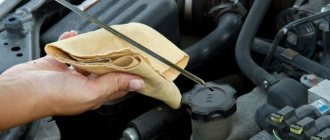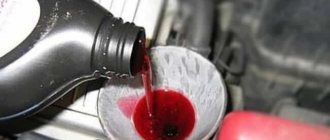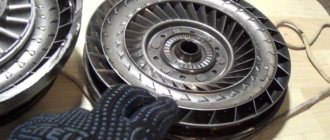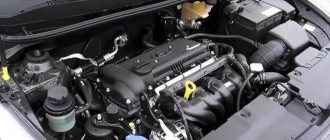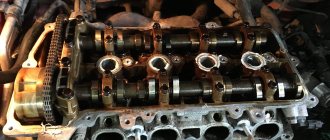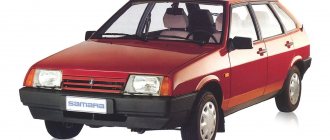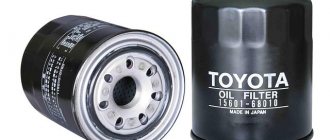Good day, dear car enthusiasts. I am sure that each of you loves your car and tries in every possible way to protect it from unnecessary breakdowns, which often occur due to premature wear of parts. Any machine is an integral organism, which consists of various components, systems and devices, comparable by analogy with the human body.
By the way, some drivers I know are truly confident that their car is a living creature that requires almost the same attention as a person, and sometimes, perhaps even persuasion and persuasion. I don’t know about you, but I don’t share this point of view, although I can agree with the parallels between the human body and the components of a car. Take the engine for example...
- 1. Express engine oil change - the essence of the procedure
- Hardware engine oil change - advantages of the technique
- Disadvantages of vacuum engine oil change
In general terms, in a car it performs the same functions as the heart in the body of each of us, which means it can also fail under unfavorable conditions. One of the main requirements for avoiding breakdowns is timely replacement of engine oil. It is this substance that reliably lubricates all moving engine parts by forming a protective oil film around them, reducing friction and accordingly increasing the service life of all components. Also, thanks to lubrication, it is possible to protect the engine from corrosion, harmful deposits or dirt, and in general, oil gives the heart of the car freshness, directing excess heat from the combustion chamber to the oil pan. As you probably already guessed, our article today will be devoted to motor oil, or rather to the process of replacing it, which, although not particularly complicated, still requires certain skills. Let's start with the characteristics of a quick replacement, also called express replacement.
Express engine oil change - the essence of the procedure
Typically, the recommended engine oil change interval is indicated in the technical documentation supplied with your vehicle. In addition, almost all packages of this lubricant indicate the approximate number of kilometers for which it should last. True, experienced drivers advise dividing each of these indicators by two, that is, changing the oil twice as often as recommended in the instructions. Thus, its level will not drop to a “critical” level, and the engine will be guaranteed to be protected.
Today, there are two main ways to change engine oil: express replacement (also called hardware or vacuum) and traditional , which uses a drain plug.
Express engine oil change is the fastest replacement method, which uses the dipstick hole to pump it out. To carry out the procedure at home, you will need light, self-contained equipment aimed at discharging the volume of air in a container using a hand pump. The container, as a rule, is chosen to be small, designed for one pumping procedure, and then the oil can be poured into something else and continued to be used.
Also, this method is used at small service stations. More reputable repair shops already use professional express replacement systems, which are distinguished by the presence of an electric compressor and a much larger capacity for pumping out oil. Some of these containers can have a volume of up to 45 liters, which is enough for 10-12 procedures. In addition, such devices have special adapters and hoses with quick-release connections, suitable for different engine models, which allows you to pump oil out of the crankcase with greater efficiency.
To change the oil using the express method, you first need to warm up the engine to operating temperature, thanks to which the oil will become less viscous and easily drain into the crankcase, from where it can be easily removed using the oil pump tube. This procedure is carried out as follows:
first, the dipstick is pulled out, in its place the specified tube is placed (it must be pushed all the way so that the end is at the bottom point of the crankcase), then it is connected to a container that creates a vacuum using a manual piston (compressor). Due to the resulting pressure difference, the oil is drawn through the tube. After the oil has been completely pumped out, the tube is pulled out and the filter element needs to be replaced. Having carried out these manipulations, you can begin to fill in new oil, just do not forget to control its level using the dipstick installed in the same place.
Of course, like any other method, this method has its pros and cons. The advantages, first of all, include:
– saving time, the ability to change the oil without using a drain plug key (especially important in problematic cases);
– no need to climb under the car (most often, it is enough to lift the hood if it is possible to open the oil filter in this way), which is undoubtedly a more convenient option.
A more detailed description of the advantages of an express oil change (hardware change) is given below. The disadvantages of this method include the risk of breaking off the tube (then it will remain inside) and pumping out a smaller amount of oil compared to removing it through the drain plug. Important to remember! Wherever an express oil change is carried out, at home or at a service station, you should definitely pay attention to the following points:
– whether the volume of drained oil is equal to the reference volume needed to fill the crankcase (the permissible difference should be no more than 200 grams, since the slight oil residue on the walls and parts of the engine is taken into account);
– whether foreign objects have been left in the engine (for example, a tube or parts of nozzles for it). Of course, if something like this happened at a service station, its employees may hide this fact from you, and to get it out you will have to remove the oil pan, which will require extra effort and time.
Hardware engine oil change - advantages of the technique
The hardware method of changing the oil is essentially the same express change described above, only when they say “hardware” they mean the use of more powerful devices, which are most often used at large specialized service stations or replacement points. The most widely used installations today are Tromelberg
and
Lubeworks
, which do not have special technological features and differ mainly only in volume and design. The main components common to various oil change machines are:
We recommend: The radio does not read the flash drive - the cause of the malfunction, methods for eliminating it
– vacuum system (mostly self-cleaning);
– a container for collecting old oil (usually in the shape of a barrel with a volume of 30 to 90 liters);
– special probes (they differ in length and diameter, they also come with replaceable couplings, usually 8 pcs.);
– pre-chambers, with the help of which you can determine the volume of waste oil extracted (not all installations have such an addition).
In the previous question, we already talked a little about the advantages of using the hardware oil change method, but now we will analyze all the advantages of this process in more detail. And so the advantages of the hardware technique include:
– the possibility of removing sediment and oil impurities from the pan as completely as possible, due to the strong pressure in the vacuum of the exhaust device (opinions differ on this matter, as some experts claim the opposite);
– environmentally friendly use, which allows you to collect used oil without allowing it to enter the environment;
– mandatory replacement of the oil filter, which will subsequently allow high-quality use of freshly filled oil for a longer period;
– saving time (it takes no more than 15 minutes, after which you can immediately continue on your way); after pumping out the used oil, new oil is immediately filled in and the car is checked for functionality;
– service station employees, when using the hardware method, select new oil based on the manufacturer’s recommendations for each specific car;
– after extracting the waste, at the client’s request, flushing liquids (oils) can be used, which are designed to remove dirt particles from the most hidden cavities of the engine.
The price of such a device in Ukraine starts from about 5,000 UAH, which is quite expensive and, of course, the average car owner will not be able to afford it, all that remains is either to contact the service center employees every time, or to change the oil yourself, in the traditional way, using available means. It is the latter option that is most often preferred by domestic car enthusiasts.
Disadvantages of vacuum engine oil change
Well, after all, express oil change has many names. Yes, yes, the concepts of “hardware”, “vacuum” and the already named “express replacement” are synonymous and characterize the same process. The name depends on the parameter to which each driver pays his attention first: the device with which the replacement is made - the apparatus, or time restrictions - the speed of the process (express), or the principle of operation of the system when removing used oil (vacuum removal).
In the previous question, we have already identified all the positive aspects of using a hardware installation, now we will look at its negative features from the point of view of using a vacuum. And so, there are only two main disadvantages of a vacuum oil change in an engine: the inability to “at the same time” check the chassis, the bottom of the car or the brake pads, since the car does not climb onto an overpass, which means you will have to spend additional time to do this and the inability to completely get rid of the so-called “heavy oil”, which consists of mixed particles of dirt, metal dust and burnt residues that settle at the bottom of the pan. This drawback is quite significant, since each time you fill in clean oil, these harmful substances will accumulate in it, thereby reducing the quality of its operation.
In a word, no one can answer you with a 100% guarantee which oil change method is best to use, but almost all experts agree that the best option would be to alternate them: traditional - vacuum (express change) - traditional, etc.
Subscribe to our feeds on social networks such as Facebook, Vkontakte, Instagram, Pinterest, Yandex Zen, Twitter and Telegram: all the most interesting automotive events collected in one place.
Hi all! How about discussing with me such a topic as express engine oil change?! I think it will be interesting for many motorists. Some will learn for the first time about the essence and features of quick replacement. Others will be able to share their own experiences and personal opinions on this matter. Just leave your feedback in the comments.
Every car enthusiast knows very well that any car with an internal combustion engine has a number of working fluids. The main one is rightly considered to be motor oil. It is this that requires periodic mandatory replacement.
There is a category of drivers who prefer to change the oil themselves. Moreover, this is far from the most complicated procedure, which does not require special equipment. But when they are too lazy to do such things, many look on the map of Moscow, cities like St. Petersburg, Petrozavodsk, Samara or Yekaterinburg for the nearest replacement points. This is already a hardware change, within which special equipment is used. Is express replacement good and what do you need to know about it? Now we'll find out.
Oil change methods
The technological process of changing the substance takes place in several stages:
- selection and purchase of filter, lubricant and flushing;
- draining the used composition;
- filling the flush and running the engine at idle speed for a certain time;
- flushing drain;
- filter replacement;
- pouring new product.
In addition to the classic method of changing the lubricant, there is also an express oil change. The difference is that in the first case a hole or overpass is required, since the oil is drained through the drain plug. A container for waste substances and a change of clothes are also required.
Express replacement is carried out through the dipstick hole. This requires special equipment. You can use professional systems that are designed for large volumes of pumped-out composition and are equipped with an electric compressor. You can also use units for home use or installations at small service stations. These are, as a rule, lightweight mobile devices that have a capacity designed to pump out a small amount of lubricant.
Express engine oil change has the following advantages:
- the procedure goes quite quickly;
- you can change the product even if you don’t have the key to the drain plug;
- there is no need to crawl under the car, all work is carried out simply with the hood open.
Among the disadvantages of the method, it is worth noting the risk of pumping out not all of the waste substance. You can also accidentally break the tube and leave it inside. It is important that only the most reliable express oil change equipment is used.
Features you need to know
The quality of the lubricant plays an important role. That is why it is important not only to select it correctly depending on the engine design and temperature conditions, but also to replace it on time, otherwise the vehicle cannot be expected to operate efficiently.
Changing engine oil using the express method requires that it be carried out at certain intervals, usually dictated by the quality of the base that is used to create the oil. It can be mineral, semi-synthetic or synthetic. In addition, it is worth considering the conditions in which the car is operated: if it experiences frequent, long-term loads or you use seasonal oils, you will have to replace it more often. As for hardware oil pumping, it can occur in several ways, depending on what equipment will be used:
- A hand pump is rarely used in car services; usually this method is used by car enthusiasts who independently service the car in the garage. It may not be possible to clean the engine completely, but the pumping procedure will take less time than a gravity drain. The method is inexpensive and accessible to everyone.
- Using a compressor is a more convenient and faster method, essentially based on the same principle as using a pump, but it makes the task much easier.
- Using a special pumping device. This device is quite expensive, so it is used in auto repair shops. The device is equipped with special reservoirs for waste liquid and may have electronic sensors. The speed of work is very high, the procedure will take no more than 15 minutes.
Before starting a hardware replacement, you need to warm up the engine well so that the oil becomes more liquid and washes off all the dirt that should come out with it from the walls. To do this, you can simply drive a few blocks down the street; if you plan to go to a service center, you will warm up the car while you get there.
Why is it necessary to change the oil?
The first thing you need to figure out is why the driver may need to change the oil urgently. As you know, the correct operation of the engine largely depends on the oil in the engine. Depending on the quality and condition of the oil, the wear of engine rubbing parts changes. Oil also affects the rate of heat removal, which is important for the engine, especially in the summer.
During operation, the oil changes its properties and characteristics. It heats up, various elements from the friction of parts get into it, oil aging processes occur, which, in general, leads to a decrease in the quality of lubrication of parts. It is because of this that in order for the oil to continue to perform its duties as best as possible, it must be changed periodically.
Hardware oil change: pros, cons, features.
| Type of work | Price | |
| Changing the oil in motorcycles | from 750 rub. | Sign up |
| Changing the engine oil and filter | from 0 rub. | Sign up |
| Oil change + crankcase protection | from 750 rub. | Sign up |
| On-site oil change | from 100 rub. | Sign up |
| Changing the automatic transmission oil | from 2500 rub. | Sign up |
| Changing the automatic transmission oil | from 0 rub. | Sign up |
Hardware oil changes have been offered at modern car service stations for many years, but for many car enthusiasts it remains a “new thing”. And therefore, debates about the advantages and disadvantages of hardware oil changes in comparison with “traditional” technology do not subside.
As a rule, any doubts and disputes arise from a lack of information. While most car owners are familiar with the technology of changing the oil “manually” (and some have repeatedly done it on their own), then a hardware oil change cannot be efficiently implemented in a standard garage; it has several stages of implementation (significantly different in quality), depending on the equipment used , and therefore remains less clear in the eyes of car owners.
Let's take a closer look at the process of hardware oil change, carried out on professional equipment, and the standard myths of car enthusiasts about the pros and cons of the technology.
Advantages and disadvantages of different oil change methods
Traditional way
Advantages:
- The maximum possible amount of old oil is drained, since the plug is located in the lower part of the crankcase;
- Along with the exhaust, dirt, slag and deposits that did not enter the oil filter are removed;
- More precise control over the volume of mining;
- It is possible to simultaneously inspect the lower part of the engine, suspension elements, etc., since you are still under the bottom.
- The oil change process follows the instructions for performing routine maintenance.
Traditional oil change method
We recommend: Motor oils and everything you need to know about motor oils for Lada Vesta
Flaws:
- More time is wasted;
- A pit, overpass or lift is required;
- The process is messier.
Express replacement
Advantages:
- Replacement is done quickly;
- The waste gets into the tank without possible contact with hands, without spilling on the floor or splashing.
- There is no need for an overpass or hole;
- The aesthetics of the process are top notch.
Flaws:
- It is impossible to pump out 100% of the waste material - the tube will not always reach the bottom point;
- There is no possibility of visual inspection of the tube inside the crankcase;
- Dirt, deposits, and slag remain at the bottom of the crankcase and mix with fresh oil;
- There is a risk of damage to the internal parts of the engine by the tube, it may break off and then the crankcase will have to be removed for removal.
- If the oil filter is accessible only from under the bottom, there is no point in express replacement; you will still need a lift or a pit.
How do I know when I need to change my oil?
Over time, your oil loses its thickness. While you may not be able to see it with your own eyes, paying close attention to your vehicle's recommended mileage and scheduled maintenance intervals will help ensure you get your oil changed before engine damage occurs. Another way to monitor this is by watching the oil monitor message on your dashboard. If your vehicle does not have this technology, low oil levels can be determined using the dipstick.
Tricky oil filter
You can replace the oil filter on your own, or with the help of a car service specialist. There is an opinion among car enthusiasts that it is not always necessary to change the filtration system every oil change cycle, especially if it is branded.
This is not true, no matter how high-quality the lubricant is, there will be a blockage in the system, albeit minor. And this will lead to the opening of the bypass valve, and the oil will flow into the internal combustion engine uncleaned, which, in turn, increases engine wear.
It is worth noting that the system pressure indicator will not light up.
Briefly about the essence of the procedure
I don’t see any point in describing in detail what express replacement is and how it is performed using certain devices of different professional levels.
Do-it-yourself plastic bumper repair: video instructions
Category: DIY repairs
I will try to briefly describe what a quick replacement is, how it differs and why this service is so often used by, let me say, lazy car owners who do not have the time or desire to fully remove old used motor oil. This is, of course, easier when at least 10 points work next to me. To be honest, I once thought about express replacement as a business idea. But soon he quickly said goodbye to her. This is an illiquid service that costs 300-500 rubles. Earnings come from others. Moreover, you will learn about this in the section about the disadvantages of this method.
Well, let's take a look at the essence of express replacement. The liquid in the form of old motor oil does not drain through a special hole, which is provided on the bottom of the crankcase on all machines.
A different approach is used for draining. Namely through the dipstick. In fact, the oil is not drained, but rather sucked out of the engine. First, the probe is simply removed and a tube is inserted into the hole formed. At the other end of this tube there is a pump and a container in which all the sucked liquid is collected. If the tube reaches the bottom of the engine crankcase, there are no particular complaints about the hardware replacement, since under such conditions it is possible to efficiently remove the old oil sediment. But the design of many engines does not allow for express replacement to reach the place where dangerous mining deposits accumulate.
The method looks quite interesting and promising. After all, it turns out that the car does not need to be lifted with a lift, on an overpass or climbed under it, which requires an additional inspection hole. The tube from the oil suction apparatus is inserted into the hole of the dipstick and the lubricant is removed using special equipment. Then all that remains is to change the old oil filter, fill in new oil such as Liqui Moly, and that’s it, the car is ready for further use. The manipulations are extremely fast and simple, which explains the name of the express replacement.
But this only at first glance seems so convenient and promising. In fact, despite the obvious advantages, a quick oil change also has its serious disadvantages. We'll talk about the pros and cons separately.
Main advantages
I’ll slightly whet your interest in the most important part of the article, and first I’ll suggest you look at the strengths of express engine oil change in a car engine.
The strengths of draining waste through the dipstick are as follows:
How does the ERA GLONASS button work on a car and why is it needed at all?
Category: Instructions
- Low price for services provided. Using the express method to pump out oil is not only quick, but also quite cheap. Although there may be additional costs involved;
- Save time. Despite the need to visit a service station where the appropriate equipment is available, draining and changing the fluid takes a minimum of time;
- No need to crawl under the car. Simply lift the hood, remove the dipstick, and pumping begins. Filling is done traditionally through the filler hole;
- The oil does not spill anywhere, does not spill onto your clothes or onto the floor;
- A professional method that involves the participation of experienced specialists in the process;
- There is no need to get rid of working off yourself.
That's all with the advantages. If you know any other strengths, write in the comments.
Key Disadvantages
I would like to remind you that express replacement also has other names. This is a vacuum and hardware replacement. But the name doesn’t change the essence.
Now it is important to focus on what disadvantages this method has and what the danger is.
One of the disadvantages is the difficulty of performing an express replacement with your own hands. Self-pumping is possible, but for this you will have to buy a special device costing about 10-15 thousand rubles minimum. For an ordinary car owner, these are completely meaningless, unjustified costs.
But I want to focus on the main drawback. Since pumping is carried out through the hole in the dipstick, the tube does not reach the bottom of the engine crankcase. What does this mean? It's simple. It is at the bottom that sediment, waste, particles of metal shavings and all those components settle that, when circulating through the lubrication system, cause damage to the engine. It is because of this sediment that it is extremely important to change the engine oil on time, otherwise rapid wear of parts simply cannot be avoided. Repeated replacement using exclusively the express method leads to the fact that the amount of sediment and metal shavings, along with other components of used oil, grows rapidly. And this is a direct threat to the integrity of the engine. You can find many visual videos online that demonstrate the consequences of incorrect oil changes.
No, express replacement has a right to exist. But only with the right approach. Experts advise alternating a quick replacement with a complete one, when all the fluid is drained, up to removing the oil pan and mechanically removing all contaminants. After serious cleaning, it is possible to change the oil using the hardware method as part of the next maintenance. But then you need to completely drain the waste through the drain hole again. At approximately every 2-3 scheduled replacement, it is a good idea to flush the engine. For this purpose, special flushing oils are used, which you can learn more about in the material at the link.
In addition to the underlying danger, there is also a risk of encountering unscrupulous service station employees. They begin to look for non-existent problems, drop oil on the engine unnoticed by you, focusing attention on the fact that your oil seals are leaking or other problems have arisen in the oil system. Plus, the expensive oil you bought can be replaced with a cheap one. There are many tricks and tricks.
We recommend: Determining the signs and causes of wheel bearing failure
You can draw the final conclusions yourself. Share your opinion in the comments and leave feedback. Thanks everyone for your attention!
Thanks for reading! Please rate the article
( 1 ratings, average: 5.00 out of 5)
Loading…
Vacuum replacement algorithm for MM
Please note that an express oil change can be done with your own hands, but you cannot do it without special equipment. So, what do we need:
- reservoir for collecting used lubricating fluid,
- probes, with the help of which technical fluids are extracted,
- device (manual, automatic or semi-automatic) for pumping out engine oil.
The procedure itself begins with warming up the power unit until it reaches operating temperatures, at which the oil becomes more fluid and easily flows into the crankcase, from where, in fact, it will be taken. As with the manual method, through the drain hole.
We turn off the engine, remove the dipstick from the standard hole (it reaches almost to the bottom of the crankcase), and instead insert a special tube or hose, which should also reach the very bottom, but not rest against it.
The second end of the hose is connected to equipment for pumping out technical fluids. When the device is turned on, it creates a vacuum in the receiving tank, and under the influence of a pressure difference, oil begins to flow from the engine crankcase to the oil-changing unit. After completing the procedure, the hose is removed, and if the engine is not supposed to be flushed, you can start filling in fresh lubricant, monitoring the level using the standard dipstick, and this must be done twice - after the first fill, you should start the engine, let it run for a few minutes and add fluid again.
We complete the event by replacing the used oil filter.
Please note that when performing a hardware oil change, done in a garage, you should pay close attention to the following points:
- the volume of drained oil must, with a certain accuracy (100-200 ml), coincide with the volume of fill specified in the technical documentation for the car of this make/model.
- when installing the pumping hose, make sure that it is secured correctly, since the lack of tightness will affect the pumping efficiency,
- When removing the tube, you also need to be careful - if it ends up without a nozzle, you will have to remove the oil pan to remove it.
When to change engine lubricant
The engine oil is constantly becoming contaminated. This is why wear of rubbing parts may increase. The reliability and service life of the internal combustion engine, its environmental performance and power depend on the purity of the lubricant.
There are two types of contaminants.
- Organic. They are formed during fuel combustion as a by-product or can be released during oxidation, polymerization and thermal decomposition of fuel and oil. The presence of water and sulfur can further complicate the situation.
- Inorganic. They are particles of mechanical wear of parts, technological contamination during engine production and repair, dust and products of spent ash additives.
Oil gets most contaminated in diesel engines. Therefore, special products with a special set of additives are produced for them.
To determine the optimal lubricant change interval, you should take into account certain factors that directly affect the composition of the engine oil:
- product quality;
- engine condition and age of the car;
- seasonality of vehicle operation (summer, winter);
- type and quality of fuel;
- driving style;
- intensity of machine use.
If you purchased a new car, then after 5000-7000 kilometers it is recommended to change the oil and then do it regularly in the future. Then the engine will work reliably and for a long time. If you bought a used car, it is better to change the lubricant immediately, despite the former owner’s assurances that he did it almost yesterday. But first of all, you need to diagnose the engine.
Many people believe that the less often a car is used, the longer it will last, and changing the engine oil can be done extremely rarely. This is a misconception, since with prolonged inactivity, condensation forms in the engine, which destroys the oil composition. That is, rare use of the car requires more frequent lubricant changes.
If a driver likes to drive around, he should be prepared for the fact that he will have to change the oxol more often, and he should choose a high-quality one. It is also very important to take into account the climatic features of the area and the time of year in the yard. You should not use a summer product at low temperatures; the car may not start.
We also note the impact of price on replacement frequency. If the oil is expensive and of high quality, then it can be replaced every 10,000-15,000 kilometers. But if you use a cheap option, you will have to change it more often - every 5000-7000 kilometers.
Oil changing units
Oil changing units can be either amateur or professional. They have significant differences from each other. Amateur ones are inexpensive installations that can be used in any garage that has a minimum set of equipment. In the process of draining used oil, they create high operating pressure in the receiving tank. That is why the pressure drop will be lower, in contrast to professional equipment that is used at service stations.
Amateur oil scraper units do not remove all used oil. A significant percentage of old liquid and heavy suspended matter will remain in the system. This option is suitable for an irregular or one-time option. But the systematic use of amateur oil scraper units is unacceptable.
When a hardware oil change is performed by qualified specialists in professional installations, the technicians maintain the required level of pressure. Thanks to this, all oil residues are completely removed. Hardware replacement is also called express replacement. Maintenance takes no more than 20 minutes. Due to the absence of additional work - removing and installing crankcase protection, motorists do not overpay for the services of specialists.
When the fluid is drained, the technician will perform a visual assessment of the fluid to assess the current condition of the system. The disadvantages include the fact that the car will not be lifted on a lift or driven onto an overpass. For this reason, the vehicle owner will not be able to combine an oil change with other diagnostic procedures.
The technicians suggest changing the oil filter in the engine along with a hardware oil change. At this point, you can perform a system cleanup. A special washing oil is used for the procedure. It guarantees complete cleaning in hard-to-reach areas of the working unit. This procedure does not need to be performed with every replacement. After completing all stages, the technician pours fresh oil into the car. After this, it is ready for further use.
What is an express oil change?
As noted above, during the standard oil change procedure, the used substance is drained through a hole in the lower part of the crankcase. During express replacement, it is removed through the hole into which the oil dipstick is inserted.
The express oil change process takes place only on a warm engine. This is due to the fact that oil heated to operating temperature has a lower viscosity, making it easier to pump out.
Important: An express oil change will not remove all the oil from the engine. If you do not bring the engine to operating temperature before starting work, you will be able to pump out even less oil due to its high viscosity.
When the engine reaches operating temperature, turn it off and remove the dipstick. A tube from a special oil pumping unit is placed in the hole for the oil dipstick. You need to insert the tube until it rests against the end.
Next, the pumping of oil into the installation begins. The installation itself is a device within which reduced pressure is created. Due to the low pressure in the device, oil begins to flow into it, being removed from the engine.
Please note: There are different installations for pumping out oil. Their main difference is the method of creating low pressure. This can be done manually or electrically.
After the maximum amount of oil has been removed from the engine, new oil is poured into it.
Features of the express procedure
This is a modern method that allows you to replace the fluid quickly and without unnecessary labor. You can do it not only in specialized auto centers, but also on your own. A special feature is the method of removing the waste substance: it is not poured out by unscrewing the plug on the engine crankcase - the oil is pumped out of the engine through a dipstick. This should be done after the engine has warmed up well.
This method of collection is considered more effective, since the waste almost does not remain in the internal space of the power unit. All contaminants also leave and do not settle at the bottom of the crankcase. The main principle is the formation of a vacuum, with the help of which it is possible to pull the waste into a container intended for collection. If you carry out the procedure in a garage, you will need a special device powered by electricity.
Devices for express oil change
We are not interested in the installations used by service stations: they are expensive and cumbersome.
Homemade device for express oil change in a car - video
But manual vacuum cleaners for garage use are worth considering in more detail. Even if you remain committed to the traditional method of changing engine oil, a tool like this can come in handy.
For example, to replace the transmission in an automatic transmission. Many manufacturers do not provide for routine maintenance on the automatic machine. That is, there are no holes for drainage and filling. In this case, a vacuum pump will help to change the engine oil.
In addition, it can be used to change the lubricant in bridges. Yes, and the traditional method of changing engine oil can be done in a comprehensive manner:
- first pump out as much waste as possible using a pump;
- then unscrew the drain plug and drain a small amount of the remaining lubricant.
But the main advantage of such a device is speed. You can quickly update the oil before an urgent trip, without even changing the filter. This method is relevant if the time limit for changing the oil has already approached, but the mileage (for filter wear) has not yet occurred.
Disadvantages of vacuum engine oil change
Unfortunately, the method in question also has its downsides. The so-called “heavy oil”, which is the most contaminated, accumulates in the lower part of the pan during the operation of the car. This “heavy” composition contains fractions that have a negative effect on the engine. These include:
- dirt particles;
- burnt remains;
- metal dust.
Vacuum engine oil change does not allow you to completely get rid of these fractions. With each new express fill, harmful suspensions in fresh oil will begin to accumulate, significantly reducing the service life of the filled liquid. For this reason, experts advise periodically changing the oil using standard technology.
One more thing. With the traditional method of filling in new lubricating fluid, a car mechanic has the opportunity to analyze the condition and functionality of various vehicle mechanisms that are located in the lower part. It is clear that with a vacuum replacement he does not have such an opportunity, because the mechanic does not even look under the bottom of the vehicle. This means that the car does not undergo preventive inspections, which can reveal any damage to automotive components.
Source
Results
- Regular oil changes can help improve the performance and fuel economy of your average car, truck or SUV. Many cars require oil changes at intervals of 3000 km. However, newer models have a much longer range between oil changes. Always refer to your vehicle's owner's manual for lubrication change intervals.
- Your dealer's certified service technicians are trained to understand how your vehicle uses its oil and how to manage its life.
- An express mixture change from a certified technician not only gives you excellent service, convenience and a great price, but it also adds value to the work done on your vehicle.
- For 2021 model year, support centers include the first required maintenance within the first year after vehicle delivery, with oil changes, rotation.
- Many vehicle warranties require two visits within the first 12 months of vehicle purchase. The warranty often provides wheel rotation testing and a multi-point vehicle inspection within the first 12 months of vehicle delivery in one service visit within the first 24 months of vehicle purchase.
